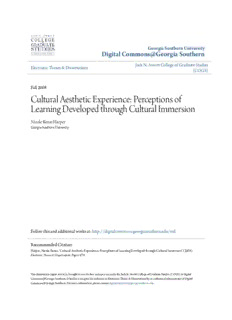
Cultural Aesthetic Experience: Perceptions of Learning Developed through Cultural Immersion PDF
Preview Cultural Aesthetic Experience: Perceptions of Learning Developed through Cultural Immersion
Georgia Southern University Digital Commons@Georgia Southern Electronic Theses and Dissertations Graduate Studies, Jack N. Averitt College of Fall 2008 Cultural Aesthetic Experience: Perceptions of Learning Developed through Cultural Immersion Nicole Renai Harper Follow this and additional works at: https://digitalcommons.georgiasouthern.edu/etd Recommended Citation Harper, Nicole Renai, "Cultural Aesthetic Experience: Perceptions of Learning Developed through Cultural Immersion" (2008). Electronic Theses and Dissertations. 479. https://digitalcommons.georgiasouthern.edu/etd/479 This dissertation (open access) is brought to you for free and open access by the Graduate Studies, Jack N. Averitt College of at Digital Commons@Georgia Southern. It has been accepted for inclusion in Electronic Theses and Dissertations by an authorized administrator of Digital Commons@Georgia Southern. For more information, please contact [email protected]. CULTURAL AESTHETIC EXPERIENCE: PERCEPTIONS OF LEARNING DEVELOPED THROUGH CULTURAL IMMERSION by NICOLE RENAI HARPER (Under the Direction of Delores Liston) ABSTRACT This study explored the role of cultural aesthetic expressions (often also referred to in this study as cultural arts) play in perceptions of learning while individuals are in the on- going process of being immersed in a non-native culture. This inquiry focused specifically on the narratives of seven expatriates undergoing the process of cultural immersion in Germany, Slovenia and the United States. Using narrative inquiry (Clandinin & Connelly, 2000; He, Phillion & Connelly, 2005), participants were engaged in discussion, observation and interview for the purpose of exploring and analyzing how they make meaning from previous knowledge and their developing encounters with aesthetic expressions, perceived of as culturally diverse from or similar to their own. The researcher’s narrative is included as a voice in the study, contributing to establishing contextual elements as well as discussing perceptions of accessibility and awareness to the aesthetic expressions in these cultures. It also includes insights reflecting upon participant narratives, referencing additional research, and citing from formal interviews and informal consultations with host-country community members who practiced in the arts and education sectors of the respective cultures. The narratives included in this dissertation offer significant evidence to suggest that intercultural literacy is developed in part through aesthetic forms of cultural exchange for this set of participants. The results of this study contribute to the discourse regarding how learning is perceived through cultural aesthetic expressions during the cultural immersion process by revealing some of the complex aspects of the meaning making process and presenting examples from lived- experience of how cross-cultural complexities are navigated by a diverse sample of individuals in relation to cultural aesthetic expressions. INDEX WORDS: Aesthetic experience, Aesthetic expression, Cross-cultural experience, Cultural arts, Cultural immersion, Cultural adaptation, Intercultural literacy, Learning, Lived experience, Narrative inquiry CULTURAL AESTHETIC EXPERIENCE: PERCEPTIONS OF LEARNING DEVELOPED THROUGH CULTURAL IMMERSION by NICOLE RENAI HARPER B.F.A., Eastern Michigan University, 1994 M.A., Michigan State University, 2001 A Dissertation Submitted to the Graduate Faculty of Georgia Southern University in Partial Fulfillment of the Requirements for the Degree DOCTOR OF EDUCATION STATESBORO, GEORGIA 2008 © 2008 Nicole R. Harper All Rights Reserved iv CULTURAL AESTHETIC EXPERIENCE: PERCEPTIONS OF LEARNING DEVELOPED THROUGH CULTURAL IMMERSION by NICOLE RENAI HARPER Major Professor: Delores Liston Committee: Ming Fang He Julie McGuire Saundra Nettles Electronic Version Approved: December 2008 v ACKNOWLEDGEMENTS I wish to thank my advisor, Delores Liston, for her guidance, patience and encouragement in the conception through completion of this dissertation. I am also pleased to thank my committee members: Ming Fang He, Julie McGuire and Saundra Nettles, for their direction, collective expertise and flexibility. I am profoundly thankful to all participants in the United States, Germany and Slovenia, who enriched my life by sharing stories from their lives and contributed invaluably to this inquiry. I am honored to thank the J. William Fulbright Foundation for financially supporting the Slovenia portion of this study through the J. William Fulbright Fellowship Grant. Furthermore I am grateful to the University of Primorska, the American Corner Koper, the United States Embassy in Ljubljana and the government of the Republic of Slovenia for their sponsorship while conducting research for this dissertation in Slovenia. I wish to also thank the College of Education and the faculty and staff from the Curriculum, Foundations and Reading Department at Georgia Southern University for the invaluable Doctoral Fellow experience and scholarship assistance and to the of Jack N. Averitt College of Graduate Studies for research grant assistance. I am pleased to recognize the combined contributions of knowledge and encouragement from my professors at Georgia Southern University during my coursework. I would also like to express gratitude to friends at the University of Mainz, Performance and Media Studies Department for their influence and participation. I am appreciative to my family and friends for their support, motivation and interest. Finally, I am especially grateful to my husband, Tim for inspiring me with love and encouragement. This dissertation is dedicated to my grandmother, Shirley Kay who has always kept me in her prayers. vi TABLE OF CONTENTS Page ACKNOWLEDGMENTS…………………………………………………………….….vi LIST OF TABLES……………………………………………………….........................ix LIST OF ILLUSTRATIONS………………………………………………………..……x CHAPTER I Introduction………………..….………..………………………………………1 Study Overview……….…………………………………………………...2 Purpose of Study………………………………………………………......3 Research Questions……………………………………………………......5 Theoretical Framework...….……..……………………………………….6 II Literature Review…………...…...………………..………………………….10 Part 1: Cultural Immersion…..………………,,……………….….…….11 Part 2: Aesthetics & Education……..…………...………………………31 Part 3: Cultural Aesthetic Experience……..……………....…………….60 Part 4: Summary of Review and Significance of Study….……...............126 III Methodology…….……………...………….…….……..………………….130 Design of Study…………….…………………………………………...132 IV Field Data & Analysis……………………………………...…..………….150 Part 1: Narratives from Participants in the United States…..….……...152 Part 2: Narratives from Participants in Germany……....……………...227 Part 3: Narratives from Participants in Slovenia…..…...……………...282 V Conclusions…….………...………………….……………………………...380 vii Findings………………………………...………………………………385 Limitations……………………………………………………………...392 Implications………………..……………………….…………………...392 REFERENCES…………………………………………………………………….…...398 APPENDICES A Participant Background Questionnaire & Interview Questions…….…..…..424 B Revised Participant Background & Interview Questions……….……..……431 C Concept Definitions and Codes (as deemed necessary)…………….….…...433 viii LIST OF TABLES Page Table 3.1: Participant Data (included narratives)………………….……….…………..143 Table 3.2: Participant Data (narratives not included)……...………………...…………144 Table 3.3: Local Participants (not presented in narrative form)………...….…………..145 Table 3.4: Research Timeline Table.………………………………….…….………….149 ix
Description: